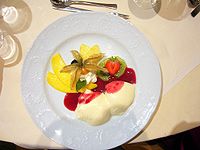
Bavarian cream
Encyclopedia

Dessert
In cultures around the world, dessert is a course that typically comes at the end of a meal, usually consisting of sweet food. The word comes from the French language as dessert and this from Old French desservir, "to clear the table" and "to serve." Common Western desserts include cakes, biscuits,...
that was included in the repertoire of Marie-Antoine Carême
Marie-Antoine Carême
Marie Antoine Carême , known as the "King of Chefs, and the Chef of Kings" was an early practitioner and exponent of the elaborate style of cooking known as haute cuisine, the "high art" of French cooking: a grandiose style of cookery favored by both international royalty and by the newly rich of...
, who is sometimes credited with it. It was named in the early 19th century for Bavaria
Bavaria
Bavaria, formally the Free State of Bavaria is a state of Germany, located in the southeast of Germany. With an area of , it is the largest state by area, forming almost 20% of the total land area of Germany...
or, perhaps more likely in the history of haute cuisine
Haute cuisine
Haute cuisine or grande cuisine was characterised by French cuisine in elaborate preparations and presentations served in small and numerous courses that were produced by large and hierarchical staffs at the grand restaurants and hotels of Europe.The 17th century chef and writer La Varenne...
, for a particularly distinguished visiting Bavarian, such as a Wittelsbach
Wittelsbach
The Wittelsbach family is a European royal family and a German dynasty from Bavaria.Members of the family served as Dukes, Electors and Kings of Bavaria , Counts Palatine of the Rhine , Margraves of Brandenburg , Counts of Holland, Hainaut and Zeeland , Elector-Archbishops of Cologne , Dukes of...
. Escoffier declared that Bavarois would be more properly Moscovite, owing to its preparation, in the days before mechanical refrigeration, by being made in a "hermetically sealed" mold that was plunged into salted crushed ice to set—hence "Muscovite".
Bavarian cream is similar to flour
Flour
Flour is a powder which is made by grinding cereal grains, other seeds or roots . It is the main ingredient of bread, which is a staple food for many cultures, making the availability of adequate supplies of flour a major economic and political issue at various times throughout history...
- or cornstarch
Cornstarch
Corn starch, cornstarch, cornflour or maize starch is the starch of the corn grain obtained from the endosperm of the corn kernel.-History:...
-thickened crème pâtissière but thickened with gelatin
Gelatin
Gelatin is a translucent, colorless, brittle , flavorless solid substance, derived from the collagen inside animals' skin and bones. It is commonly used as a gelling agent in food, pharmaceuticals, photography, and cosmetic manufacturing. Substances containing gelatin or functioning in a similar...
instead and flavoured with liqueur
Liqueur
A liqueur is an alcoholic beverage that has been flavored with fruit, herbs, nuts, spices, flowers, or cream and bottled with added sugar. Liqueurs are typically quite sweet; they are usually not aged for long but may have resting periods during their production to allow flavors to marry.The...
. It is lightened with whipped cream when on the edge of setting up, before being molded, for a true Bavarian cream is usually filled into a fluted mold, chilled until firm, then turned out onto a serving plate. By coating a chilled mold first with a fruit gelatin, a glazed effect can be produced. Imperfections in the unmolding are disguised with strategically placed fluted piping of crème Chantilly. In the United States, it is not uncommon to serve Bavarian cream directly from the bowl it has been chilled in, similar to a French mousse
Mousse
Mousse is derived from the French word mousse which means "lather" or "foam". A mousse is a prepared food that incorporates air bubbles to give it a light and airy texture...
. In this informal presentation, Escoffier recommended the Bavarian cream be made in a "timbale or deep silver dish which is then surrounded with crushed ice".
It may be served with a fruit sauce or a raspberry
Raspberry
The raspberry or hindberry is the edible fruit of a multitude of plant species in the genus Rubus, most of which are in the subgenus Idaeobatus; the name also applies to these plants themselves...
or apricot
Apricot
The apricot, Prunus armeniaca, is a species of Prunus, classified with the plum in the subgenus Prunus. The native range is somewhat uncertain due to its extensive prehistoric cultivation.- Description :...
purée
Purée
Purée and mash are general terms for cooked food, usually vegetables or legumes, that have been ground, pressed, blended, and/or sieved to the consistency of a soft creamy paste or thick liquid. Purées of specific foods are often known by specific names, e.g., mashed potatoes or apple sauce...
or used to fill elaborate charlottes
Charlotte (dessert)
A charlotte is a type of dessert that can be served hot or cold. It can also be known as an "ice-box cake". Bread, sponge cake or biscuits/cookies are used to line a mould, which is then filled with a fruit puree or custard...
.
Though it does not pipe smoothly because of its gelatin, it could substitute at a pinch for crème pâtissière as a filling for doughnut
Doughnut
A doughnut or donut is a fried dough food and is popular in many countries and prepared in various forms as a sweet snack that can be homemade or purchased in bakeries, supermarkets, food stalls, and franchised specialty outlets...
s. The American "Bavarian Cream doughnuts" are actually filled with a version of a crème pâtissière, causing local linguistic confusion.
True Bavarian creams first appeared in the U.S. in Boston Cooking School cookbooks, by Mrs D.A. Lincoln, 1884, and by Fannie Merritt Farmer, 1896: Fannie Farmer already offers a "Quick Bavarian Cream".

